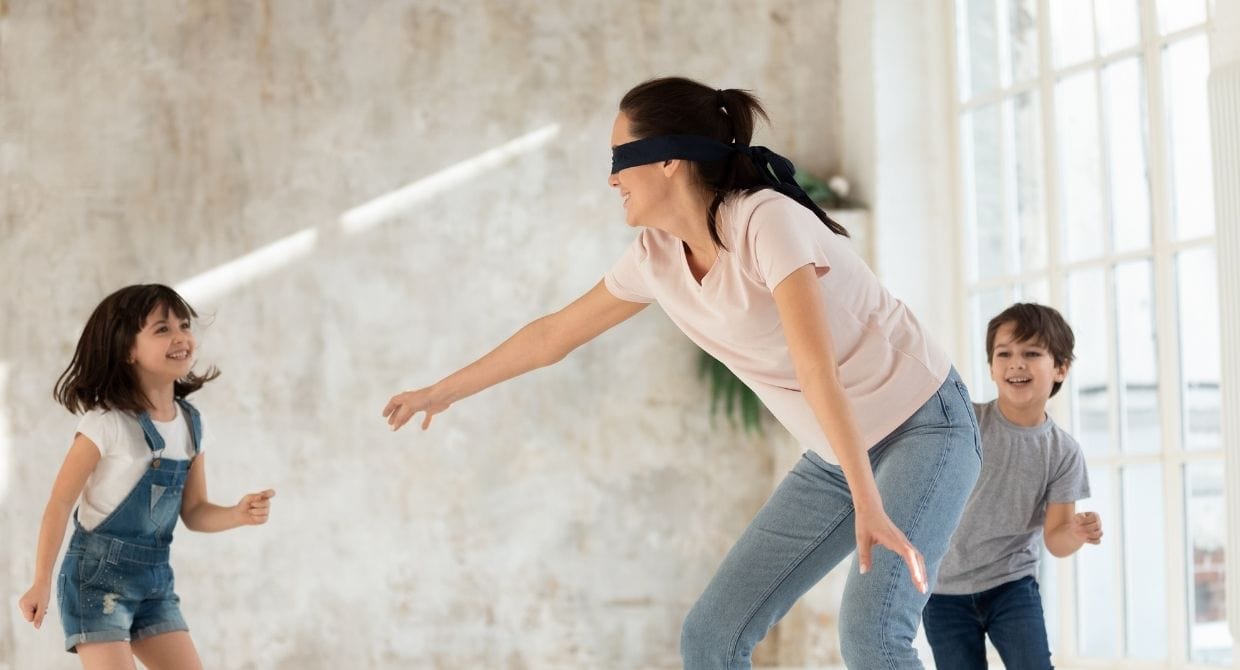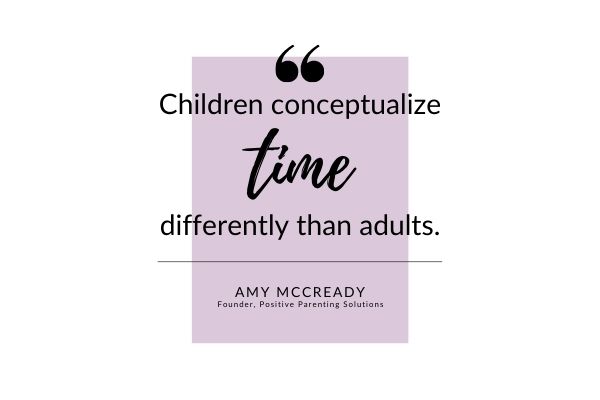5 Ways to Connect With Your Child…On Their Level
“Marco!”
“Polo!”
Through the darkness, you hear the sound of your children stifling their giggles as you wave your hands around, trying to catch them.
To be honest, this has never been your favorite game. You can think of loads of activities you’d rather be doing than fumbling around the house blindfolded. (Ouch! Was that coffee table always there?)
But to your kids, it’s the best game on the planet! So you play.
A lot.
But despite your lack of enthusiasm for the game, you have started to notice that something interesting happens after every play session.
Your kids’ attitudes change…for the better!
But do you know why?
It has nothing to do with the game itself and everything to do with how you as a parent interact with them.
I can’t tell you how many parents have taken our FREE WEBINAR or purchased the full 7-Step Parenting Success System® online training program
, all looking for answers to this very same question.
How do I change my child’s misbehavior?
And my answer always begins the same way. It all starts with YOU!
That’s right; your actions as a parent have a powerful correlation with the misbehavior you’re seeing in your children.
Now, please don’t think I’m here to point fingers! At some point in time, every parent comes to realize the role they play in their children’s behavior. I’m just here to help!
Believe it or not, one of the key ways you can change misbehavior (for the better!) is to connect with your kids on their level. Because you can’t expect your kids to think like adults. They’ve never been there before!
But you can certainly think like your kids. And I promise, when you shift your mindset to one that more closely reflects your child’s–that’s where the magic happens! You’ll enjoy deeper connections, more cooperation, and better behavior in no time.
Want a little help getting into that mindset? Here are five strategies to help get you out of your world…and into theirs!
1. Channel Your Inner Child
One of the best ways to connect with your child is to shift your mindset to one that more closely resembles their own.
In other words, I want you to act, play, and think…like a kid!
You see, we all start out in life with that beautiful childlike mentality. Do you remember looking up at the sky and seeing the shapes made in the clouds?
There’s a rhino chasing a bunny rabbit! That one looks like a donut with a bite taken out of it!
But now, when you look up at the sky, all you see are puffy, white, cumulonimbus clouds. Each shape is an obscure blob that doesn’t look like anything at all.
You remember that childish imagination and sense of wonder, but you lost the ability to channel it somewhere along the path to adulthood.
And, oh, what you wouldn’t give to have it back!
Here’s the thing. For adults, it is harder to channel our inner child. And for good reason! After all, how much of our day do we spend at work, in meetings, doing chores, and taking care of our children?
All of those tasks require us to be in an adult mindset. So naturally, that’s where we default to most often.
But if you want to connect with your child on a deeper, more meaningful level, something’s got to give. And I think you know what that something is…
You need to enter what is known as the Child Ego State. This is the state of thinking your kids are engaged in during a significant portion of their day. And it’s (usually) a wonderful place to be!
Now, this comes with a bit of a Catch 22. Because, as all parents know, the child mindset is highly emotional. Which is not always a good thing. (Remember those terrible two tantrums?)
Your job is to stick to the fun end of the spectrum.
Let’s say you want to bond with your 5-year-old son. Try and remember what it was like to be his age. What did that feel like? How amazing was it to just play? What sort of things did you love when your parents played with you?
Perhaps you enjoyed building LEGO cities with your mom or roughhousing with your dad in the backyard. It was so easy to live in the moment, forget every problem in your life, and simply be a kid.
Now take that feeling and bring it to life. The chores can wait. Dinner can be pushed. Age yourself down and engage with your child.
I promise if you make it a habit to bring out your inner child at least once each day, as time goes on it will get easier to make that mental shift. And the more you engage in childlike play with your kid, the better behavior you’re going to see on their end.
Because when we play with our kids, we send them a very important message without saying a word.
I love our time together. You’re so special to me.
It gives them a massive boost of positive attention that they’ll gladly exchange for better behavior.
Helpful Hint: Did you know there are two other ego states we engage in that often escalate power struggles? the 7-Step Parenting Success System® online training program
unpacks each one, giving you valuable insight into how your state of personality affects your child’s behavior.
2. Schedule Daily One-on-One Time
Want to know the best medicine for treating misbehavior? Spending quality time with your child!
It’s no secret our children desire our time and attention. Okay, if you’re the parent of a teenager, you may be rolling your eyes right now. But it’s still important!
In fact, the most powerful tool in the Positive Parenting Solutions® toolbox is what we refer to as MIND, BODY AND SOUL TIME® togetherness.
MIND, BODY AND SOUL TIME® togetherness occurs when we intentionally set aside time each day to emotionally connect and pour attention into our kids one-on-one. This time is absolutely critical because not only does it tell our children how much we value them–it shows them!
What child wouldn’t want that?
However, for this prescription to work, you’ve got to give your kids a daily dose. Two if you can spare it!
It doesn’t have to be long–10-15 minutes will do just fine–but it does need to happen regularly. Your kids need to know they can count on receiving that special time with you. Because if you don’t give them your full attention in a controlled and calm environment, they will get it other ways.
This is also the best time to get into that Child Ego State we just covered.
Start by asking your child what they would like to do during your special time together.
“I’m so excited for our special time today! What sounds fun?”
Maybe your 3-year-old wants to play a round of Candy Land, or your 13-year-old is just dying to show you his perfected ollie at the skate park. Try to go along with whatever they chose for the activity, even if it’s not your favorite.
When you take the time to connect with your child by doing something they want to do (rather than what you want to do), you’re giving yourself a fantastic gift: a peek into your child’s world!
Pro Tip: Positive Parenting Solutions® Members–learn more about the benefits of MIND, BODY AND SOUL TIME® connection by reviewing Step 1 of the 7-Step Parenting Success System. And also, review the advanced module, “The Busy Parent’s Guide to MIND, BODY AND SOUL TIME®.”
3. Take Time Away From Technology
At the end of a long workday, I understand how appealing it is to slip on your most comfortable pajamas, and lay in bed mindlessly scrolling through social media while the kids are in bed fast asleep.
Because nothing says “distraction” from life’s hardships quite like technology.
Plus, it’s a wonderful tool that serves a purpose. BUT it’s important to set limits both for yourself and your children when it comes to its use.
Because for as many positives technology brings to our lives as parents, it can be equally problematic.
For instance…
How discouraging is it when you ask your child to finish their Family Contributions, but they’re stuck playing on the iPad? Honestly, it’s probably just as discouraging for them when they ask you a question, and you’re glued to your phone.
Too much tech time isn’t just a kid issue. We all face the urge to overdo it now and again. But when you’re looking to build a connection with your child, it’s important to put aside those external distractions and live in the moment.
So, where are some areas of life you can cut the tech?
How about in the car? Turn down the radio, have your child put away any games they may be playing, and strike up a conversation! You can ask them what they are most looking forward to that day or even play a few rounds of I Spy.
I’m telling you, some of the best heart-to-hearts you’ll ever have with your children will take place on the road.
Another great place to cut out technology is at the family table.
It seems to be a dying tradition with the modern family’s busy schedule, but making time to eat dinner (or another meal) together as a family without technology is a connection-building goldmine!
Sometimes family meals are the only opportunity you have for the entire family to get together at once. So don’t waste that precious time by bringing technology into the mix.
Set the phones in the kitchen, turn off the television, and enjoy one another’s company. If you’re unsure how to get the conversation rolling, get yourself a set of Table Topics or Google some ideas beforehand. You’d be surprised how quickly conversations spark when the right questions are asked.
Finally, try adding in an occasional tech-free day or weekend. This doesn’t have to happen all the time, or even on a regular schedule (unless you want it to!). Make it memorable by picking a fun activity to do together–something out of the norm.
Maybe you take a trip to the mountains for a family hike or spend the afternoon playing mini-golf and riding go-karts at your local adventure park. What you do isn’t important, as long as the time you spend together is meaningful and uninterrupted.
Before too long, you and your kids will crave the special time together. Technology will be nothing but an afterthought.
4. Slow Down
“Hurry up and finish your breakfast, or you’ll miss the bus!”
“Don’t dawdle through the grocery store aisles; we’ve got places to be.”
“Piano lessons start at 3:45, so no playing around after school today!”
Do any of these sound familiar?
As parents, it’s natural for us to place the schedule above all else. After all, having a well-oiled daily routine can feel like a matter of survival, especially when our children thrive on routines.
But as the saying goes, sometimes you need to stop and smell the roses.
Because children conceptualize time differently than adults.
Every year that goes by, time seems to speed up more and more. Yesterday you were your child’s age, then you blinked, and here you are. You think, Where did the time go?
Of course, we know time operates the same yesterday, today, and tomorrow. There will always be 60 seconds in a minute, 60 minutes in an hour, and 24 hours in a day. But that doesn’t mean it feels the same for everyone.
In fact, the younger you are, the slower time feels.
That’s because children absorb an abundance of new information every single day. They feel each of those seconds passing because their young minds are working overtime trying to make sense of what’s going on around them!
But as much as you may want them to hurry up, you’re going to get so much more out of your interaction if, instead, you slow down.
That ladybug on the sidewalk may seem unimportant to you as you hurry your toddler to daycare. But to her, it’s the most important thing in her ever-expanding world.
So if you can, ignore the pressing schedule for just a few moments and admire it with her. By slowing down for her, you’ll be giving her an extra dose of your time and attention–something she most definitely craves!
5. Schedule a Yes Day
How many times each day do you say the word “no” to your child?
My guess is a lot.
“No, you can’t eat ice cream right before dinner.”
“No video games until you’ve finished all your homework.”
“No, you can’t jump from the roof to the trampoline–that’s crazy!”
“No. No. No. No. NO!”
The problem with “no” is that it’s disheartening for both them and us. Our kids can’t stand having their requests constantly turned down, and we dislike always having to be the bad guy.
We know there are some situations where “no” is unavoidable. Like, “No, you can’t play with that chainsaw!”
But I challenge you to focus on turning some of those “no” answers into “yes” answers.
One way to do this is to simply shift your phrasing. In other words, make your “no” sound like a “yes.”
For example, you could say, “Unfortunately, only adults are allowed to use the chainsaw. But I’d love it if you brought your play tools out to help me in the yard!”
See how I snuck that “no” in there without ever having to actually say it?
Of course, you also want to start handing out more real “yes” answers too. And one fantastic way to do that is by scheduling a Yes Day.
A Yes Day is precisely what it sounds like. It’s one full day making an active effort to say “yes” to all your child’s requests.
You’ll want to use your discretion and keep the requests within reason. Otherwise, your twelve-year-old who desperately wants to go skydiving may take advantage. But this isn’t the time to be stingy with the little things, either.
In other words, step out of your comfort zone and say “yes” to ice cream for breakfast or Christmas pajamas all day long (even in July).
Just be sure that your Yes Day is not a last-minute decision. This is one event you need to schedule in advance. Also, bring your kids in on it. Let them know when this will be taking place, so they have time to plan out what they will be asking that day.
This will also allow you to go over the ground rules and mentally prepare yourself for the day.
As terrifying as a Yes Day may sound to you, I promise, this is going to be a major highlight when your kids look back on their childhoods. They’ll think, Wow, Mom and Dad not only listened to what I wanted to do–they actually did it!
The amount of belonging and significance they’ll feel will be astronomical.
Final Thoughts
If you’ve been longing to connect with your child on a deeper level, don’t wait another minute to take action. Now is the time to reach out and get on their level!
Because the truth is, it wasn’t that long ago you were a child yourself. It may take some time, energy, and practice on your part, but connecting with your children on their level is a surefire way to reduce the amount of misbehavior you see every day.
Now get out there, and think like a kid!
What You Should Do Next:
1. Get Quick Actionable TIPS delivered to your inbox
Sign up for my newsletter for parenting tips to help you create a happier home and become the parent you always wanted to be. Plus, when you subscribe, I'll also send you a copy of our strategy-packed guide 10 Tips for Better Behavior – Starting NOW!
2. Unlock the secrets to easier parenting in my FREE CLASS
Register for my free class called How to Get Kids to Listen, Without Nagging, Yelling or Losing Control. Classes run several times per week to accommodate your busy schedule.
3. Transform your family with the 7-Step Parenting Success System® Course
Join the hundreds of thousands of parents who have transformed their families with the 7-Step Parenting Success System® Course. Learn the tools you need to raise happy, respectful, responsible kids and create the family life you always dreamed of having.
About the Author








